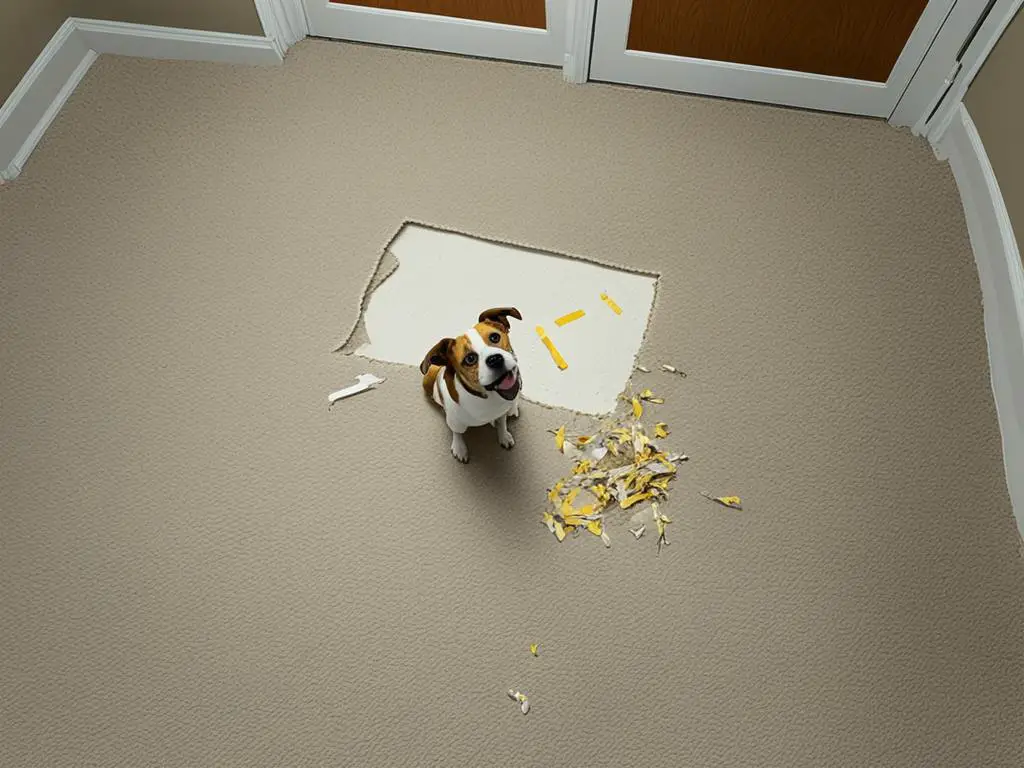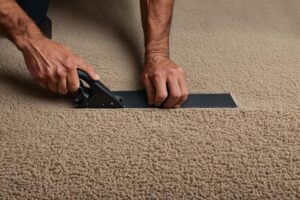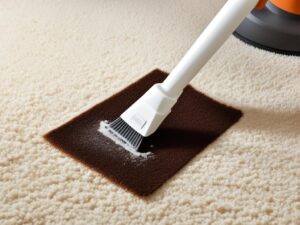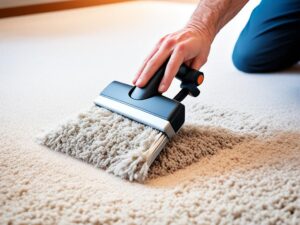Dogs tearing up the carpet when left alone can be a frustrating and distressing problem for both pet owners and their furry companions. This destructive behavior is often a symptom of separation anxiety, an emotional disorder that affects many dogs. Understanding the causes of separation anxiety and implementing effective strategies can help prevent your dog from damaging the carpet and alleviate their distress.
Key Takeaways:
- Separation anxiety can cause dogs to tear up the carpet when left alone.
- Understanding the signs and symptoms of separation anxiety is crucial in addressing the issue.
- Factors like lack of socialization, re-homing, dominant relationships, and genetic predisposition can contribute to separation anxiety.
- Strategies such as patient and understanding approach, providing physical and mental exercise, desensitization, gradual increase in alone time, and seeking professional help can help prevent carpet damage.
- By implementing these strategies, dog owners can create a more positive and stress-free environment for their pets when they are left alone.
Understanding Separation Anxiety in Dogs
Dogs with separation anxiety can exhibit various destructive behaviors when left alone. These behaviors may include whining, pacing, chewing furniture, destroying blinds, and ripping up carpeting. Separation anxiety is an emotional disorder that can cause distress for dogs as well as problems with neighbors and landlords. It is important to understand the signs and symptoms of separation anxiety in order to address the issue effectively.
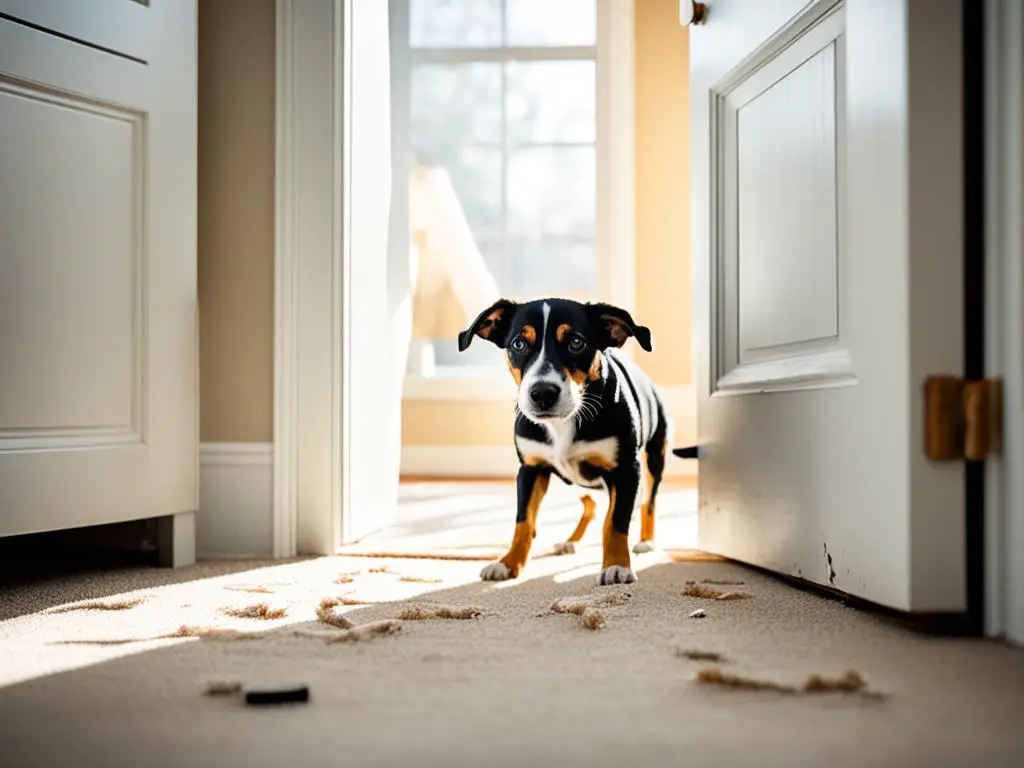
“Separation anxiety is a common issue faced by many pet owners. Understanding the underlying causes and identifying the specific behaviors associated with separation anxiety are crucial steps in finding appropriate solutions.”
The first step in addressing separation anxiety is to recognize its symptoms. Some common signs of separation anxiety include excessive whining, pacing back and forth near doors or windows, destructive chewing of furniture or household items, destroying blinds, ripping up carpeting, and attempting to escape from the house. These behaviors are not indicative of a poorly trained or disobedient dog, but rather a response to the stress and anxiety experienced when left alone.
Causes of Separation Anxiety
There are several factors that can contribute to the development of separation anxiety in dogs. These may include:
- Lack of proper socialization during puppyhood
- Frequent changes in homes or owners (re-homing)
- Pre-existing dominant relationship with the owner
- Genetic predisposition to anxiety
Understanding the underlying causes of separation anxiety can help in creating targeted strategies to alleviate the problem.
| Common Destructive Behaviors | Prevention Strategies |
|---|---|
| Whining | Provide comfort items (such as a favorite toy or blanket) and use positive reinforcement to associate being alone with positive experiences. |
| Pacing | Engage in physical exercise before leaving to help your dog release energy. Create a designated area for your dog to walk or run around safely when alone. |
| Chewing furniture | Provide appropriate chew toys and redirect your dog’s attention to them when they start chewing on furniture. Use deterrent sprays or covers to protect furniture. |
| Destroying blinds | Close blinds or curtains before leaving to limit visual stimulation that may trigger anxiety. Consider using heavy-duty blinds or installing window film for added protection. |
| Ripping up carpeting | Use positive reinforcement to redirect your dog’s behavior towards appropriate chewing toys. Cover exposed areas of carpet with protective mats or rugs. |
Causes of Separation Anxiety in Dogs
Separation anxiety in dogs can be attributed to various factors, each contributing to the development of this distressing condition. By understanding the underlying causes, it becomes possible to implement targeted strategies to alleviate separation anxiety and promote a healthier relationship between dogs and their owners.
1. Lack of Socialization
Lack of proper socialization during a dog’s developmental stages can contribute to separation anxiety later in life. Dogs that have not been exposed to a variety of people, animals, and environments may become overly dependent on their owners and experience anxiety when left alone.
2. Re-homing and Instability
Frequent changes in homes or owners, often due to re-homing, can disrupt a dog’s sense of security and create anxiety-related behaviors. Dogs that have experienced multiple transitions may struggle with trust and attachment, leading to separation anxiety.
3. Dominant Relationship
A dominant relationship between a dog and its owner can also contribute to separation anxiety. When a dog views their owner as the pack leader and becomes excessively reliant on their presence, they may experience distress when left alone.
4. Genetic Predisposition
Some dogs may have a genetic predisposition to separation anxiety. Certain breeds, such as the Labrador Retriever and German Shepherd, have been found to be more susceptible to developing separation anxiety than others. It is important for owners to be aware of their dog’s breed tendencies and take appropriate measures to prevent or manage separation anxiety.
“Understanding the causes of separation anxiety can help in creating targeted strategies to alleviate the problem.”
It is worth noting that separation anxiety can be influenced by a combination of these causes and can manifest differently in each dog. By identifying the contributing factors specific to an individual dog, owners can tailor their approach to effectively address separation anxiety and promote a sense of calm and security.
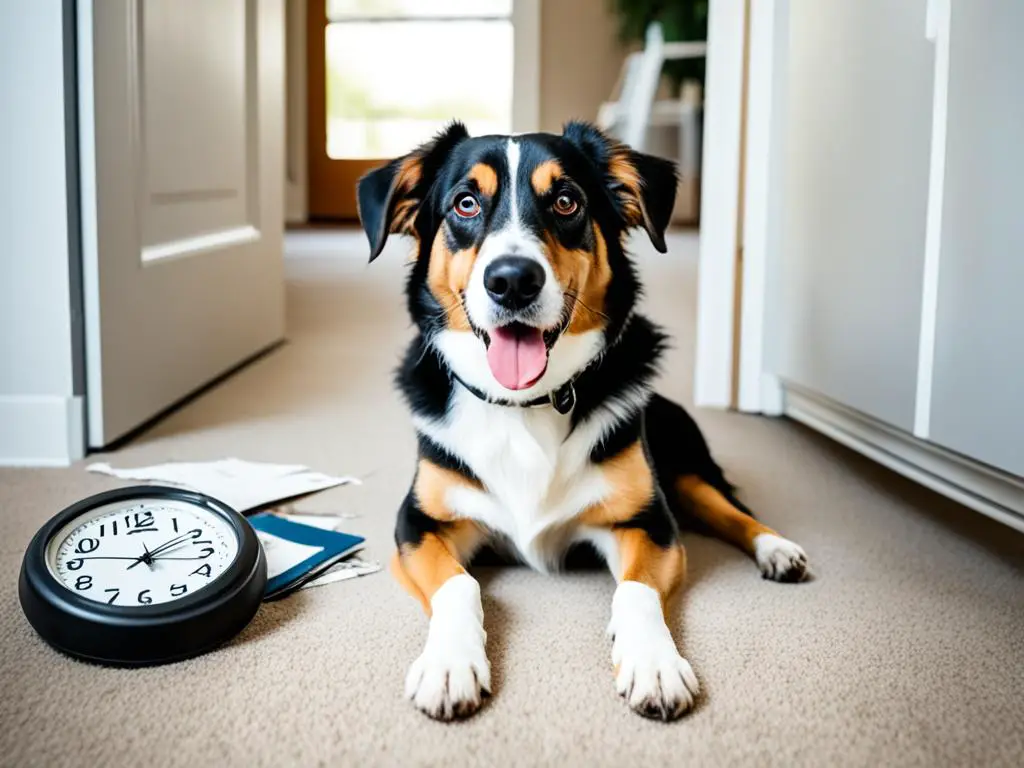
Strategies to Prevent Dog Tears Up Carpet When Left Alone
If your dog has separation anxiety and tends to tear up the carpet when left alone, there are several effective strategies that can help you address this behavior. By being patient and understanding, providing ample physical and mental exercise, and gradually increasing the time spent alone, you can help your dog feel more secure and prevent carpet damage. Here are some key strategies to consider:
1. Be Patient and Understanding
Separation anxiety can be a distressing experience for dogs, so it’s important to be patient and understanding. Punishing or scolding your dog for destructive behavior will only exacerbate their anxiety. Instead, offer reassurance and positive reinforcement when they exhibit calm behavior.
2. Provide Physical and Mental Exercise
Keep your dog physically and mentally stimulated to help alleviate anxiety. Regular exercise, such as walks or play sessions, can help burn off excess energy and provide an outlet for their anxiety. Mental stimulation, such as puzzle toys or training activities, can also keep their minds occupied and help prevent boredom-related behaviors.
3. Desensitize Your Dog to Departure Cues
Many dogs with separation anxiety become anxious as soon as they notice the signs of their owner preparing to leave. Gradually desensitize your dog to these departure cues by practicing them without actually leaving. For example, pick up your keys or put on your shoes and then sit back down without leaving. This can help reduce your dog’s anxiety around these cues.
4. Gradually Increase Alone Time
Help your dog build confidence by gradually increasing the amount of time they spend alone. Start with short periods and gradually extend the duration as your dog becomes more comfortable. This gradual increase allows them to adjust to being alone without triggering excessive anxiety.
5. Seek Professional Help if Needed
If your dog’s separation anxiety is severe or persists despite your efforts, seeking professional help from a veterinarian or a qualified dog behaviorist is recommended. They can provide guidance, tailor a behavior modification plan for your dog, and recommend additional strategies or therapies if necessary.
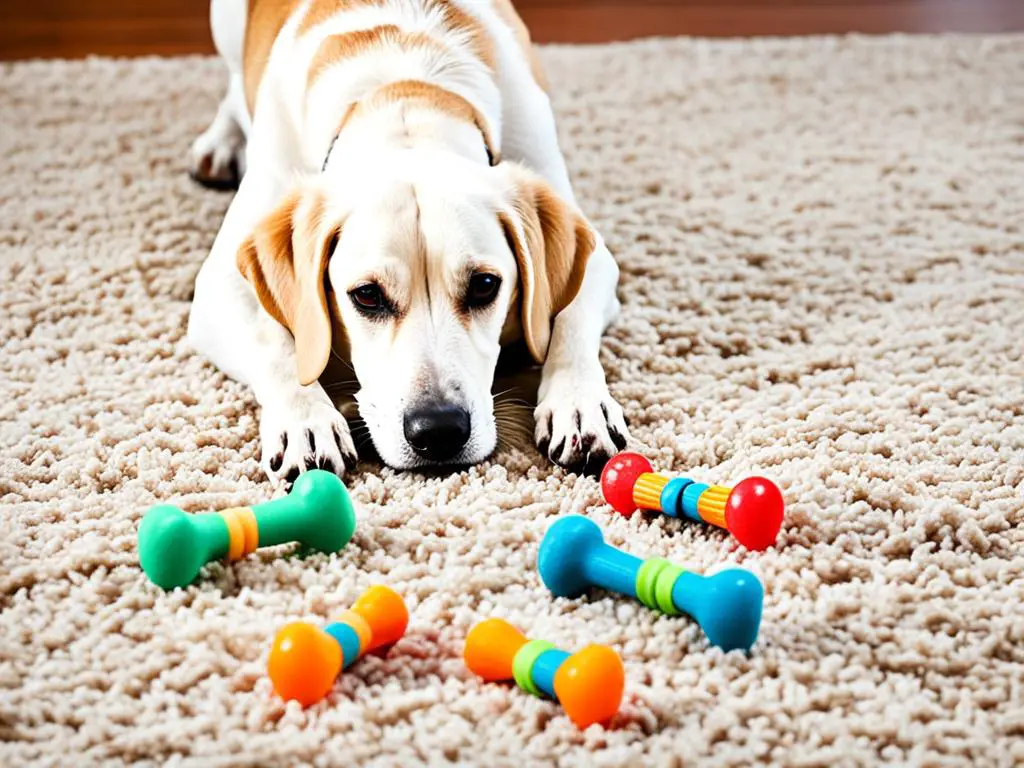
By implementing these strategies, you can prevent your dog from tearing up the carpet when left alone due to separation anxiety. Remember, every dog is unique, so it’s important to find an approach that works best for your furry friend. With patience, consistency, and potentially professional support, you can help your dog feel more secure and avoid carpet damage.
Conclusion
Dealing with separation anxiety in dogs and preventing them from tearing up the carpet when left alone can be a challenging task. However, with a thorough understanding of the causes and effective strategies, dog owners can create a positive and stress-free environment for their furry friends.
By implementing the strategies mentioned in this article, such as providing ample physical and mental exercise, desensitizing the dog to departure cues, and gradually increasing the time spent alone, dog owners can help prevent destructive behaviors caused by separation anxiety.
Remember, patience and consistency are key when dealing with separation anxiety. It is important to approach the training process with empathy and understanding. Seeking professional help when needed can also provide valuable guidance in addressing separation anxiety and preventing carpet damage.
With the right strategies and a little bit of time and effort, dog owners can greatly reduce the chances of their pets tearing up the carpet due to separation anxiety. By creating a safe and secure environment for their dogs, owners can ensure that both they and their furry companions can enjoy a happier and more harmonious relationship.
